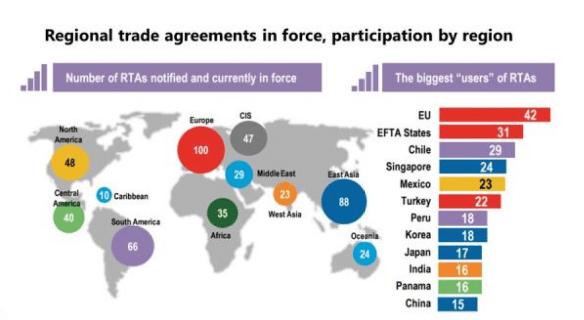Regional Trade Agreements | Crash Course for UGC NET Commerce PDF Download
Regional Trade Agreement (RTA)
A Regional Trade Agreement (RTA) is a pact between several countries within a specific geographical region, primarily aimed at reducing or eliminating trade barriers among the member countries. These agreements can vary in complexity, ranging from simple free trade zones to more intricate structures like economic or monetary unions. Typically, RTAs include internal rules that apply exclusively to member states, while external trade policies may vary depending on the level of consensus achieved among the members. Examples of RTAs include the North American Free Trade Agreement (NAFTA), the Central American-Dominican Republic Free Trade Agreement (CAFTA-DR), the European Union (EU), and the Asia-Pacific Economic Cooperation (APEC).
Types of Regional Trade Agreements

RTAs can be categorized into six types:
Preferential Trading Area: This type involves the least commitment, as member states do not fully eliminate trade barriers. Instead, they reduce tariffs and provide preferential access for certain products.
Free Trade Area: In a free trade area, member countries agree on advantageous trade terms, tariff reductions, and other benefits for each other. For example, India has free trade agreements with several nations, including Sri Lanka, and economic blocs like ASEAN.
Customs Union: A customs union involves an agreement to reduce or eliminate tariffs and trade barriers between member countries. Typically, members also apply a common external tariff on imports from non-member countries. The European Union (EU) serves as an example.
Common Market: Expanding on the customs union, a common market allows for the free movement of labor and capital among member states. The Benelux common market, which existed until 1959 before evolving into an economic union, is an example.
Economic Union: This is a trade bloc combining a single market and a single customs union. It allows for shared product regulation, free movement of goods, services, and production factors (capital and labor), along with a unified external trade policy.
Monetary Union: In a monetary union, two or more countries adopt a single currency and permanently fix the exchange rates of their national currencies that existed prior to the union's formation.
Benefits of Regional Trade Agreements
RTAs offer several benefits, including:
- Broader Market Access: Member countries gain access to larger markets.
- Economic Growth: RTAs stimulate economic development.
- Job Creation: Increased trade activities result in more employment opportunities.
- Access to Capital: Member countries benefit from cheaper and more abundant capital.
- Stronger Negotiation Position: RTAs enhance member countries' bargaining power in international treaties.
- Consumer Benefits: Consumers enjoy access to higher-quality, lower-cost goods due to the free flow of trade.
- Innovation and Quality Improvement: Competition within the bloc drives innovation and improves product quality.
Conclusion
The number of regional trade agreements is on the rise, and their nature is evolving. In 1990, there were about fifty trade agreements in force, whereas by 2017, the number had increased to over 280. Modern trade agreements often extend beyond tariffs to include a range of policy areas impacting trade and investment, such as competition policy, government procurement laws, and intellectual property rights. RTAs focusing solely on tariffs and border measures are termed "shallow" agreements, while those covering a broader array of policy areas are known as "deep" agreements.
|
157 videos|236 docs|166 tests
|
FAQs on Regional Trade Agreements - Crash Course for UGC NET Commerce
| 1. What are the different types of Regional Trade Agreements? |  |
| 2. What are some of the benefits of Regional Trade Agreements? |  |
| 3. How do Regional Trade Agreements benefit participating countries? |  |
| 4. What are some examples of Regional Trade Agreements around the world? |  |
| 5. How do Regional Trade Agreements impact non-member countries? |  |
















